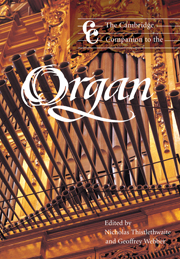Book contents
- Frontmatter
- Part I The instrument
- Part II The player
- Part III Selected repertoires
- 10 Italian organ music to Frescobaldi
- 11 Iberian organ music before 1700
- 12 The French classical organ school
- 13 English organ music to c1700
- 14 Catholic Germany and Austria 1648–c1800
- 15 The north German organ school
- 16 The organ music of J. S. Bach
- 17 German organ music after 1800
- 18 French and Belgian organ music after 1800
- 19 British organ music after 1800
- 20 North American organ music after 1800
- Appendix: The modes (toni) and their attributes according to Zarlino
- Notes
- Bibliography
- Index
Appendix: The modes (toni) and their attributes according to Zarlino
from Part III - Selected repertoires
Published online by Cambridge University Press: 28 September 2011
- Frontmatter
- Part I The instrument
- Part II The player
- Part III Selected repertoires
- 10 Italian organ music to Frescobaldi
- 11 Iberian organ music before 1700
- 12 The French classical organ school
- 13 English organ music to c1700
- 14 Catholic Germany and Austria 1648–c1800
- 15 The north German organ school
- 16 The organ music of J. S. Bach
- 17 German organ music after 1800
- 18 French and Belgian organ music after 1800
- 19 British organ music after 1800
- 20 North American organ music after 1800
- Appendix: The modes (toni) and their attributes according to Zarlino
- Notes
- Bibliography
- Index
Summary
The following summary may serve as an introduction to the modes, the basis of all organ music through to the seventeenth century. The voice-ranges of the twelve modes are given, the white note being the key-note. All are in their untransposed state with the exception of modes II and XI, which have been transposed respectively up a fourth and down a fifth, reflecting common usage. All pairs of modes function regularly:in the odd-numbered modes Tenor (and Soprano) use the authentic scale, Alto and Bass the plagal scale. In the even-numbered modes the roles are reversed except in the case of mode IV,which is often almost indistinguishable from mode III, having sometimes a smaller range, sometimes a larger one, especially at the upper end of the Soprano. In all cases it is quite normal to extend the voice-range occasionally by one or possibly two notes. For further reading see Meier 1992 and the present writer’s introduction to his edition of Giovanni de Macque’s Ricercari sui Dodici Toni.Unless otherwise stated, the descriptions represent a précis of the widely-known account of the modes given by Gioseffo Zarlino in his Le istitutioni harmoniche of 1558.
Information
- Type
- Chapter
- Information
- The Cambridge Companion to the Organ , pp. 316 - 318Publisher: Cambridge University PressPrint publication year: 1999
